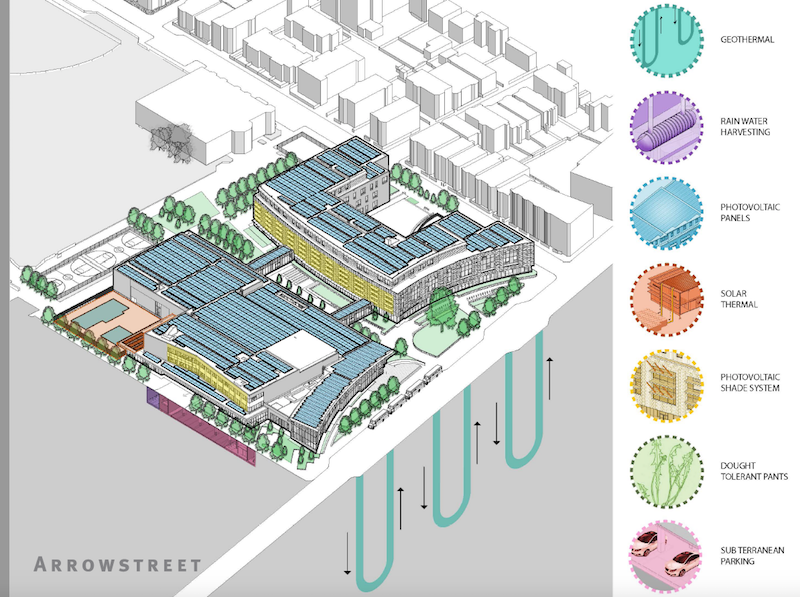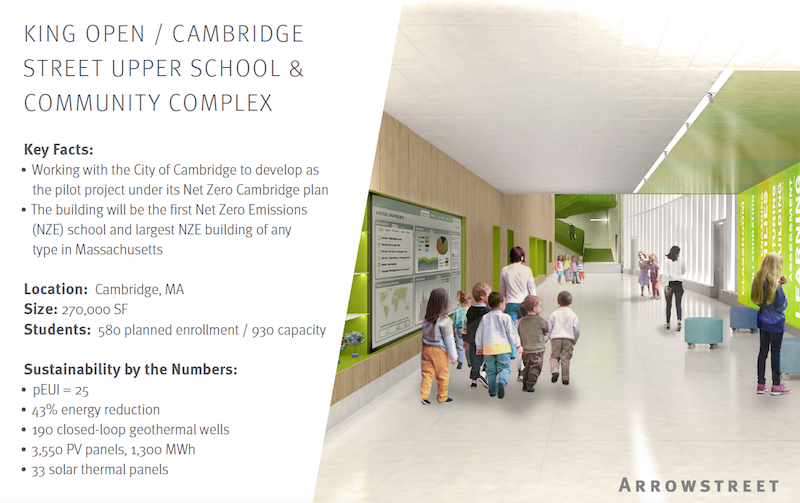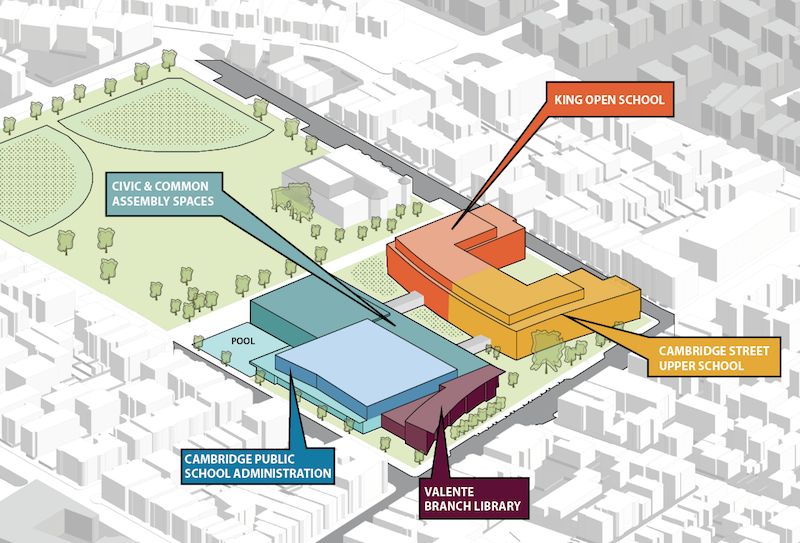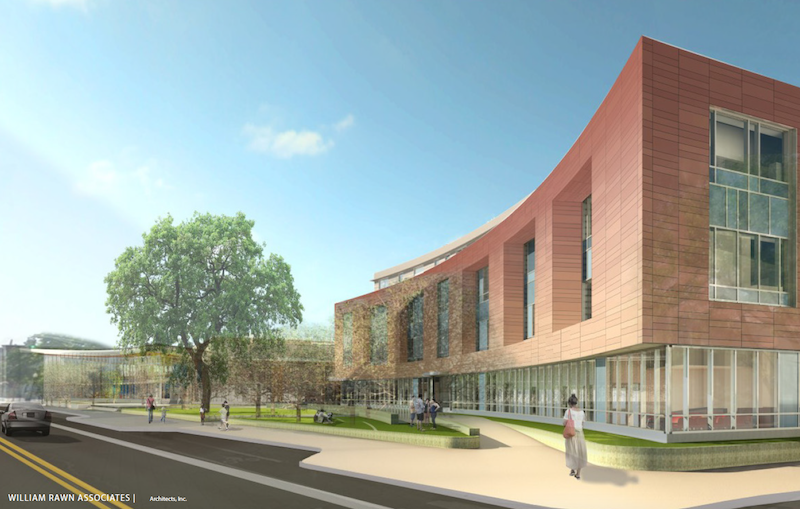The first Net Zero Emissions school, and the largest NZE building of any type, in Massachusetts is under construction in East Cambridge.
In collaboration with William Rawn Associates, Boston-based architectural firm Arrowstreet has designed this 270,000-sf building, which will house King Open School for grades K-5 and Cambridge Street Upper School for grades 6-8. The schools will have separate entrances as well as their own academic, physical education, and administrative facilities, but will share common spaces that will include the media center, cafeteria, and auditorium.
The complex will have a branch of the public library, a Gold Star swimming pool, a subterranean parking garage, and the district offices for the city’s public schools department.
Arrowstreet has been working with Cambridge to develop the building as a pilot project under the city’s recently enacted New Zero Cambridge plan. (This is the second, and largest, of four schools planned under that program over the next two decades.)

The building will include a host of energy-saving elements (see above), including a geothermal system with 190 wells (see below). Images: Arrowstreet

To that end, 3,550 solar panels will generate between 60% and 75% of the building’s energy. A geothermal system with 190 wells dug 500 feet underground will provide heat and cooling during summer and winter months, and be supplemented by a separate ventilation system. All of the building’s lights are LEDs.
The building will be all-electric, and therefore combustion-free. Each school, as well as the library and cafeteria, will be equipped with a dashboard that measure electricity consumption, says Larry Spang, a Principal with Arrowstreet. He adds that the dashboards will contribute to the schools’ “problem-solving curriculum,” and help teach students about environmental sustainability.
The software for the dashboards is in development, says Spang.

The school will be the largest NZE building in Massachusetts, and will include dashboards that measure the electricity used and generated by the building, and double as educational tools. Image: Arrowstreet.
Arrowstreet got the contract for this project in 2014, and presented its feasibility study the following year. A team led by Arrowstreet’s Director of Sustainability and Building Performance Kate Bubriski spent a year talking to more than 30 community groups about their needs and expectations. The team also spent time with the school district’s facilities department to assess the comfort levels required for building’s different rooms.
“The old school was pretty traditional and isolated from the community,” says Bubriski. She adds that the school itself had very few areas for group learning or teacher interaction.
The new building doubles the programming and room space. And the building will stay open nights and weekends to provide more access for the community for such things as English as a second language courses, and gym time for sports leagues.
The schools are designed with “team rooms” within clusters of classrooms, says Spang.

The complex will include a branch of the city's public library, a swimming pool, and administrative offices for the school district. Image: Arrowstreet.
As of last week the building’s foundation was in place and one-third of the west side is completed. It is scheduled to open by the summer of 2019; until then, its students are in temporary classrooms in other locations of the city.
Along with Arrowstreet and William Rawn Associates, the Building Team on this project includes Copley Wolff Design Group (landscape architect), Nitsch Engineering (CE), LeMessurier Consultants (SE), Garcia Galuska Desousa (MEP/FP/Security/Telecom), Aquatic Design Group (pool consultant), and Acentech (AV consultant).
Related Stories
| Aug 11, 2010
Nursing home turned charter school opens in Dorchester, Mass.
Cambridge, Mass.-based HMFH Architects spearheaded the design for the conversion of a former nursing home in Dorchester, Mass., to learning and community space for the Neighborhood House Charter School. The pre-K—8 school has two classrooms for each elementary grade level, clusters of middle school classrooms, a cafeteria, media center, and art, computer, music and science classrooms.
| Aug 11, 2010
Modest recession for education construction
Construction spending for education expanded modestly but steadily through March, while at the same time growth for other institutional construction had stalled earlier in 2009. Education spending is now at or near the peak for this building cycle. The value of education starts is off 9% year-to-date compared to 2008.
| Aug 11, 2010
Las Vegas high school focuses on careers in justice, emergency response
McCarthy Building Cos., St. Louis, recently completed construction on the 130,700-sf Veterans Tribute Career & Technical Academy, a Las Vegas high school that focuses on service career pathways in 911 dispatch training, law enforcement, crime scene analysis, emergency medical training, and computer forensics.
| Aug 11, 2010
Three Schools checking into L.A.'s Ambassador Hotel site
Pasadena-based Gonzalez Goodale Architects is designing three new schools for Los Angeles Unified School District's Central Wilshire District. The $400 million campus, located on the site of the former Ambassador Hotel, will house a K-5 elementary school, a middle school, a high school, a shared recreation facility (including soccer field, 25-meter swimming pool, two gymnasiums), and a new publ...
| Aug 11, 2010
7 Keys to Unlocking Energy Efficiency in Schools
Today’s best K-12 schools are embracing the sustainability ethos in their design and construction, and that can mean a healthier, more comfortable indoor environment and improved learning. Some studies contend that ample amounts of daylighting, for example, lead to higher test scores. High-performance HVAC systems that constantly draw fresh air into a classroom seem to help both teachers ...
| Aug 11, 2010
Blue-Light Schoolhouses
Add the explosion in the number of school-aged kids nationally to the glut of huge, vacant stores in many communities and what do you get? Big boxes being turned into schools. For districts facing population pressure, these empty retail buildings can be the key to creating classrooms quickly, and at a significant cost advantage.
| Aug 11, 2010
Great Solutions: Green Building
27. Next-Generation Green Roofs Sprout up in New York New York is not particularly known for its green roofs, but two recent projects may put the Big Apple on the map. In spring 2010, the Lincoln Center for the Performing Arts will debut one of the nation's first fully walkable green roofs. Located across from the Juilliard School in Lincoln Center's North Plaza, Illumination Lawn will consist ...
| Aug 11, 2010
Dream Fields, Lone Star Style
How important are athletic programs to U.S. school districts? Here's one leading indicator: In 2005, the National Football League sold 17 million tickets. That same year, America's high schools sold an estimated 225 million tickets to football games, according to the American Football Coaches Association.
| Aug 11, 2010
Back to Nature: Can wood construction create healthier, more productive learning environments?
Can the use of wood in school construction create healthier, safer, more productive learning environments? In Japan, there's an ongoing effort by government officials to construct school buildings with wood materials and finishes—everything from floors and ceilings to furniture and structural elements—in the belief that wood environments have a positive impact on students.
| Aug 11, 2010
High School in a Hurry
One of the more compelling arguments for charter schools is their theoretical ability to streamline decision making. Eliminate all those layers of bureaucratic fat that clog the arteries of most public school systems, the argument goes, and decisions can be made to flow much more smoothly, even when it comes to designing and building a major school project.







